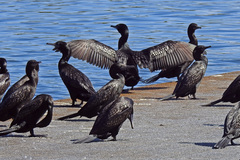The Little Black Cormorant is a small, slim, totally black cormorant with a greenish sheen to the back and a slender grey hooked bill.
You can help suppport me bringing this information to you via my Paypal
What habitats does Phalacrocorax sulcirostris live in?
The Little Black Cormorant is mainly found in freshwater wetlands, but will sometimes be found on sheltered coastal waters, and can use relatively small, deep water bodies. It is strongly aquatic, seldom being seen on dry land, but is often seen resting on rocks, jetties and other perches in water.
What is the distribution of Phalacrocorax sulcirostris?
Widespread in Australia. It is also found from Borneo and Java, Indonesia, to Papua New Guinea, Vanuatu, New Caledonia, Solomon Islands, Palua and New Zealand
How big does Phalacrocorax sulcirostris grow?
55 - 65 cm Long with a wingspan of 95 - 105 cm
You can support me by dropping some funds into my Paypal account
Disclaimer: A lot of work goes into trying to identify and ensure accurate identifications are made and that the listed Descriptions, Sizes, Habitats and Distribution information is as accurate and valid as possible. Unfortunately, information in this arena is ever changing and as such no guarantee can be offered that it is correct or currently valid as a result the information is provided as a guide, and it is always suggested that you do a little research to ensure you have the latest and most accurate information. View the reference's or bibliography I welcome any feedback and comments on the information provided.

